Biology quiz questions and answers
Biology quiz questions and answers
The following texts are the property of their respective authors and we thank them for giving us the opportunity to share for free to students, teachers and users of the Web their texts will used only for illustrative educational and scientific purposes only.
All the information in our site are given for nonprofit educational purposes
The information of medicine and health contained in the site are of a general nature and purpose which is purely informative and for this reason may not replace in any case, the council of a doctor or a qualified entity legally to the profession.
Biology quiz questions and answers
Biology, 7e (Campbell)
Chapter 5: The Structure and Function of Macromolecules
Chapter Questions
1) Which of the following is not one of the four major groups of macromolecules found in living organisms?
A) glucose
B) carbohydrates
C) lipids
D) proteins
E) nucleic acids
Answer: A
Topic: Overview
Skill: Knowledge
2) Polymers of polysaccharides, fats, and proteins are all synthesized from monomers by which process?
A) connecting monosaccharides together (condensation reactions)
B) the addition of water to each monomer (hydrolysis)
C) the removal of water (dehydration reactions)
D) ionic bonding of the monomers
E) the formation of disulfide bridges between monomers
Answer: C
Topic: Concept 5.1
Skill: Comprehension
3) Which of the following best summarizes the relationship between dehydration reactions and hydrolysis?
A) Dehydration reactions assemble polymers, and hydrolysis breaks down polymers.
B) Hydrolysis only occurs in the urinary system, and dehydration reactions only occur in the digestive tract.
C) Dehydration reactions can occur only after hydrolysis.
D) Hydrolysis creates monomers, and dehydration reactions break down polymers.
E) A and C are correct.
Answer: A
Topic: Concept 5.2
Skill: Comprehension
4) A molecule with the chemical formula C16H32O16 is probably a
A) carbohydrate.
B) lipid.
C) protein.
D) nucleic acid.
E) hydrocarbon.
Answer: A
Topic: Concept 5.2
Skill: Comprehension
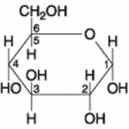
Figure 5.1
5) If 128 molecules of the general type shown in Figure 5.1 were covalently joined together in sequence, the single molecule that would result would be a
A) polysaccharide.
B) polypeptide.
C) polyunsaturated lipid.
D) monosaccharide.
E) disaccharide.
Answer: A
Topic: Concept 5.2
Skill: Comprehension
6) Consider a polysaccharide consisting of 576 glucose molecules. The total hydrolysis of the polysaccharide would result in the production of
A) 575 glucose molecules.
B) 575 water molecules.
C) 576 glucose molecules.
D) A and B only
E) B and C only
Answer: C
Topic: Concept 5.2
Skill: Comprehension
7) Lactose, a sugar in milk, is composed of one glucose molecule joined by a glycosidic linkage to one galactose molecule. How is lactose classified?
A) as a pentose
B) as a hexose
C) as a monosaccharide
D) as a disaccharide
E) as a polysaccharide
Answer: D
Topic: Concept 5.2
Skill: Comprehension
8) Which of the following are polysaccharides?
A) glycogen
B) starch
C) chitin
D) A and B only
E) A, B, and C
Answer: E
Topic: Concept 5.2
Skill: Knowledge
9) Which of the following is true of both starch and cellulose?
A) They are both polymers of glucose.
B) They are geometric isomers of each other.
C) They can both be digested by humans.
D) They are both used for energy storage in plants.
E) They are both structural components of the plant cell wall.
Answer: A
Topic: Concept 5.2
Skill: Knowledge
10) Which of the following is true of cellulose?
A) It is a polymer composed of sucrose monomers.
B) It is a storage polysaccharide for energy in plant cells.
C) It is a storage polysaccharide for energy in animal cells.
D) It is a major structural component of plant cell walls.
E) It is a major structural component of animal cell plasma membranes.
Answer: D
Topic: Concept 5.2
Skill: Knowledge
11) Humans can digest starch but not cellulose because
A) the monomer of starch is glucose, while the monomer of cellulose is galactose.
B) humans have enzymes that can hydrolyze the beta (β) glycosidic linkages of starch but not the alpha (α) glycosidic linkages of cellulose.
C) humans have enzymes that can hydrolyze the alpha (α) glycosidic linkages of starch but not the beta (β) glycosidic linkages of cellulose.
D) humans harbor starch-digesting bacteria in the digestive tract.
E) the monomer of starch is glucose, while the monomer of cellulose is maltose.
Answer: C
Topic: Concept 5.2
Skill: Comprehension
12) A molecule with the formula C18H36O2 is probably a
A) carbohydrate.
B) lipid.
C) protein.
D) nucleic acid.
E) hydrocarbon.
Answer: B
Topic: Concept 5.3
Skill: Comprehension
13) Which of the following is (are) true for the class of large biological molecules known as lipids?
A) They are insoluble in water.
B) They are an important constituent of cell membranes.
C) They contain twice as much energy as an equivalent weight of polysaccharide.
D) Only A and B are correct.
E) A, B, and C are correct.
Answer: E
Topic: Concept 5.3
Skill: Knowledge
14) Triacylglycerol is a
A) protein with tertiary structure.
B) lipid made with three fatty acids and glycerol.
C) lipid that makes up much of the plasma membrane.
D) molecule formed from three alcohols by dehydration reactions.
E) carbohydrate with three sugars joined together by glycosidic linkages.
Answer: B
Topic: Concept 5.3
Skill: Knowledge
15) Saturated fatty acids
A) are the predominant fatty acid in corn oil.
B) have double bonds between carbon atoms of the fatty acids.
C) have a higher ratio of hydrogen to carbon than do unsaturated fatty acids.
D) are usually liquid at room temperature.
E) are usually produced by plants.
Answer: C
Topic: Concept 5.3
Skill: Knowledge

Figure 5.2
16) What is the molecule illustrated in Figure 5.2?
A) a saturated fatty acid
B) an unsaturated fatty acid
C) a polyunsaturated triacylglyceride
D) a trans polyunsaturated triacylglyceride
E) a steroid similar to cholesterol
Answer: A
Topic: Concept 5.3
Skill: Knowledge

Figure 5.3
17) The molecule shown in Figure 5.3 is a
A) polysaccharide.
B) polypeptide.
C) saturated fatty acid.
D) triacylglycerol.
E) unsaturated fatty acid.
Answer: E
Topic: Concept 5.3
Skill: Knowledge
18) The hydrogenation of vegetable oil would result in which of the following?
A) a decrease in the number of carbon-carbon double bonds in the oil (fat) molecules
B) an increase in the number of hydrogen atoms in the oil (fat) molecule
C) the oil (fat) being a solid at room temperature
D) A and C only
E) A, B, and C
Answer: E
Topic: Concept 5.3
Skill: Comprehension
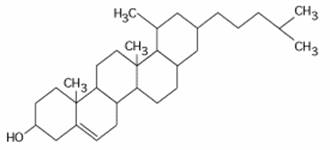
Figure 5.4
19) What is the structure shown in Figure 5.4?
A) starch molecule
B) protein molecule
C) steroid molecule
D) cellulose molecule
E) phospholipid molecule
Answer: C
Topic: Concept 5.3
Skill: Knowledge
20) A polypeptide can best be described as a
A) monomer of a protein polymer.
B) polymer containing 20 amino acid molecules.
C) polymer containing 19 peptide bonds.
D) polymer containing 20 peptide bonds.
E) polymer of amino acids.
Answer: E
Topic: Concept 5.4
Skill: Knowledge
21) The 20 different amino acids found in polypeptides exhibit different chemical and physical properties because of different
A) carboxyl groups attached to an alpha (α) carbon
B) amino groups attached to an alpha (α) carbon
C) side chains (R groups).
D) alpha (α) carbons.
E) asymmetric carbons.
Answer: C
Topic: Concept 5.4
Skill: Knowledge
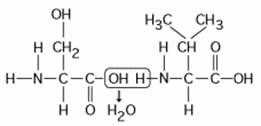
Figure 5.5
22) The chemical reaction illustrated in Figure 5.5 results in the formation of a (an)
A) ionic bond.
B) peptide bond.
C) glycosidic linkage.
D) ester linkage.
E) phosphodiester linkage.
Answer: B
Topic: Concept 5.4
Skill: Comprehension
23) The bonding of two amino acid molecules to form a larger molecule requires which of the following?
A) removal of a water molecule
B) addition of a water molecule
C) formation of an ionic bond
D) formation of a hydrogen bond
E) both A and C
Answer: A
Topic: Concept 5.4
Skill: Comprehension
24) Polysaccharides, lipids, and proteins are similar in that they
A) are synthesized from monomers by the process of hydrolysis.
B) are synthesized from monomers by dehydration reactions.
C) are synthesized as a result of peptide bond formation between monomers.
D) are decomposed into their subunits by dehydration reactions.
E) all contain nitrogen in their monomer building blocks.
Answer: B
Topic: Concepts 5.1-5.4
Skill: Knowledge
25) Dehydration reactions are used in forming which of the following compounds?
A) triacylglycerides
B) polysaccharides
C) proteins
D) A and C only
E) A, B, and C
Answer: E
Topic: Concepts 5.1-5.4
Skill: Knowledge
26) Upon chemical analysis, a particular protein was found to contain 556 amino acids. How many peptide bonds are present in this protein?
A) 139
B) 554
C) 555
D) 556
E) 558
Answer: C
Topic: Concept 5.4
Skill: Comprehension
Refer to Figure 5.6 to answer the following questions.
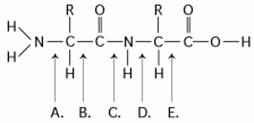
Figure 5.6
27) At which bond would water need to be added to achieve hydrolysis of the peptide, back to its component amino acid?
Answer: C
Topic: Concept 5.4
Skill: Comprehension
28) Which bond is closest to the N-terminus of the molecule?
Answer: A
Topic: Concept 5.4
Skill: Comprehension
29) Which bond is closest to the C-terminus of the molecule?
Answer: E
Topic: Concept 5.4
Skill: Comprehension
30) How many different kinds of polypeptides, each composed of 12 amino acids, could be synthesized using the 20 common amino acids?
A) 412
B) 1220
C) 125
D) 20
E) 2012
Answer: E
Topic: Concept 5.4
Skill: Application
31) Which bonds are created during the formation of the primary structure of a protein?
A) peptide bonds
B) hydrogen bonds
C) disulfide bonds
D) phosphodiester bonds
E) A, B, and C
Answer: A
Topic: Concept 5.4
Skill: Knowledge
32) What maintains the secondary structure of a protein?
A) peptide bonds
B) hydrogen bonds
C) disulfide bonds
D) ionic bonds
E) phosphodiester bonds
Answer: B
Topic: Concept 5.4
Skill: Knowledge
33) Which type of interaction stabilizes the alpha (α) helix and the beta (β) pleated sheet structures of proteins?
A) hydrophobic interactions
B) nonpolar covalent bonds
C) ionic bonds
D) hydrogen bonds
E) peptide bonds
Answer: D
Topic: Concept 5.4
Skill: Knowledge
34) The α helix and the β pleated sheet are both common polypeptide forms found in which level of protein structure?
A) primary
B) secondary
C) tertiary
D) quaternary
E) all of the above
Answer: B
Topic: Concept 5.4
Skill: Knowledge
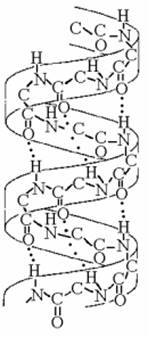
Figure 5.7
35) Figure 5.7 shows the
A) 1-4 linkage of the α glucose monomers of starch.
B) 1-4 linkage of the β glucose monomers of cellulose.
C) double helical structure of a DNA molecule.
D) α helix secondary structure of a polypeptide.
E) β pleated sheet secondary structure of a polypeptide.
Answer: D
Topic: Concept 5.4
Skill: Comprehension
36) Figure 5.7 best illustrates the
A) secondary structure of a polypeptide.
B) tertiary structure of a polypeptide.
C) quaternary structure of a protein.
D) double helix structure of DNA.
E) primary structure of a polysaccharide.
Answer: A
Topic: Concept 5.4
Skill: Comprehension
37) The tertiary structure of a protein is the
A) bonding together of several polypeptide chains by weak bonds.
B) order in which amino acids are joined in a polypeptide chain.
C) unique three-dimensional shape of the fully folded polypeptide.
D) organization of a polypeptide chain into an α helix or β pleated sheet.
E) overall protein structure resulting from the aggregation of two or more polypeptide subunits.
Answer: C
Topic: Concept 5.4
Skill: Knowledge
38) A strong covalent bond between amino acids that functions in maintaining a polypeptide's specific three-dimensional shape is a (an)
A) ionic bond.
B) hydrophobic interaction.
C) van der Waals interaction.
D) disulfide bond.
E) hydrogen bond.
Answer: D
Topic: Concept 5.4
Skill: Knowledge
39) At which level of protein structure are interactions between the side chains (R groups) most important?
A) primary
B) secondary
C) tertiary
D) quaternary
E) all of the above
Answer: C
Topic: Concept 5.4
Skill: Knowledge
40) The R group or side chain of the amino acid serine is –CH2-OH. The R group or side chain of the amino acid alanine is –CH3. Where would you expect to find these amino acids in a globular protein in aqueous solution?
A) Serine would be in the interior, and alanine would be on the exterior of the globular protein.
B) Alanine would be in the interior, and serine would be on the exterior of the globular protein.
C) Both serine and alanine would be in the interior of the globular protein.
D) Both serine and alanine would be on the exterior of the globular protein.
E) Both serine and alanine would be in the interior and on the exterior of the globular protein.
Answer: B
Topic: Concept 5.4
Skill: Application
41) The globular protein transthyretin results from the aggregation of four polypeptide subunits. Each of the subunits is a polypeptide chain with an α helix region. Which structure(s) must the transthyretin protein have?
A) primary structure
B) primary and secondary structure
C) primary, secondary, and tertiary structure
D) primary, secondary, tertiary, and quaternary structure
E) primary, secondary, tertiary, quaternary, and alpha structure
Answer: D
Topic: Concept 5.4
Skill: Comprehension
42) What would be an unexpected consequence of changing one amino acid in a protein consisting of 325 amino acids?
A) The primary structure of the protein would be changed.
B) The tertiary structure of the protein might be changed.
C) The biological activity or function of the protein might be altered.
D) Only A and C are correct.
E) A, B, and C are correct.
Answer: E
Topic: Concept 5.4
Skill: Comprehension
43) Altering which of the following levels of structural organization could change the function of a protein?
A) primary
B) secondary
C) tertiary
D) quaternary
E) all of the above
Answer: E
Topic: Concept 5.4
Skill: Comprehension
44) All of the following molecules are proteins except
A) hemoglobin.
B) transthyretin.
C) collagen.
D) lysozyme.
E) glycogen.
Answer: E
Topic: Concept 5.4
Skill: Knowledge
45) What is the term used for a change in a protein's three-dimensional shape or conformation due to disruption of hydrogen bonds, disulfide bridges, or ionic bonds?
A) hydrolysis
B) stabilization
C) destabilization
D) renaturation
E) denaturation
Answer: E
Topic: Concept 5.4
Skill: Knowledge
46) What is the term used for a protein molecule that assists in the proper folding of other proteins?
A) tertiary protein
B) chaperonin
C) enzyme protein
D) renaturing protein
E) denaturing protein
Answer: B
Topic: Concept 5.4
Skill: Knowledge
47) Of the following functions, the major purpose of RNA is to
A) transmit genetic information to offspring.
B) function in the synthesis of protein.
C) make a copy of itself, thus ensuring genetic continuity.
D) act as a pattern or blueprint to form DNA.
E) form the genes of higher organisms.
Answer: B
Topic: Concept 5.5
Skill: Comprehension
48) Which of the following best describes the flow of information in eukaryotic cells?
A) DNA → RNA → proteins
B) RNA → proteins → DNA
C) proteins → DNA → RNA
D) RNA → DNA → proteins
E) DNA → proteins → RNA
Answer: A
Topic: Concept 5.5
Skill: Comprehension
49) Which of the following descriptions best fits the class of molecules known as nucleotides?
A) a nitrogenous base and a phosphate group
B) a nitrogenous base and a pentose sugar
C) a nitrogenous base, a phosphate group, and a pentose sugar
D) a phosphate group and an adenine or uracil
E) a pentose sugar and a purine or pyrimidine
Answer: C
Topic: Concept 5.5
Skill: Knowledge
50) Which of the following are nitrogenous bases of the pyrimidine type?
A) guanine and adenine
B) cytosine and uracil
C) thymine and guanine
D) ribose and deoxyribose
E) adenine and thymine
Answer: B
Topic: Concept 5.5
Skill: Knowledge
51) Which of the following are nitrogenous bases of the purine type?
A) cytosine and guanine
B) guanine and adenine
C) adenine and thymine
D) thymine and uracil
E) uracil and cytosine
Answer: B
Topic: Concept 5.5
Skill: Knowledge
52) All of the following nitrogenous bases are found in DNA except
A) thymine.
B) adenine.
C) uracil.
D) guanine.
E) cytosine.
Answer: C
Topic: Concept 5.5
Skill: Knowledge
53) A double-stranded DNA molecule contains a total of 120 purines and 120 pyrimidines. This DNA molecule could be comprised of
A) 120 adenine and 120 uracil molecules.
B) 120 thymine and 120 adenine molecules.
C) 120 cytosine and 120 thymine molecules.
D) 240 adenine and 240 cytosine molecules.
E) 240 guanine and 240 thymine molecules.
Answer: B
Topic: Concept 5.5
Skill: Application
54) The difference between the sugar in DNA and the sugar in RNA is that the sugar in DNA
A) is a six-carbon sugar and the sugar in RNA is a five-carbon sugar.
B) can form a double-stranded molecule.
C) has a six-membered ring of carbon and nitrogen atoms.
D) can attach to a phosphate.
E) contains one less oxygen atom.
Answer: E
Topic: Concept 5.5
Skill: Knowledge
55) Which of the following statements best summarizes the structural differences between DNA and RNA?
A) RNA is a protein, whereas DNA is a nucleic acid.
B) DNA is a protein, whereas RNA is a nucleic acid.
C) DNA nucleotides contain a different sugar than RNA nucleotides.
D) RNA is a double helix, but DNA is single-stranded.
E) A and D are correct.
Answer: C
Topic: Concept 5.5
Skill: Knowledge
56) In the double helix structure of nucleic acids, cytosine hydrogen bonds to
A) deoxyribose.
B) ribose.
C) adenine.
D) thymine.
E) guanine.
Answer: E
Topic: Concept 5.5
Skill: Knowledge
57) The two strands making up the DNA double helix molecule
A) cannot be separated.
B) contain ribose and deoxyribose in opposite strands.
C) are held together by hydrogen bonds.
D) are attached through a phosphate to hold the strands together.
E) contain uracil but not thymine.
Answer: C
Topic: Concept 5.5
Skill: Knowledge
58) If one strand of a DNA molecule has the sequence of bases 5'ATTGCA3', the other complementary strand would have the sequence
A) 5'TAACGT3'.
B) 3'TAACGT5'.
C) 5'UAACGU3'.
D) 3'UAACGU5'.
E) 5'UGCAAU3'.
Answer: B
Topic: Concept 5.5
Skill: Knowledge
59) The structural feature that allows DNA to replicate is the
A) sugar-phosphate backbone.
B) complementary pairing of the nitrogenous bases.
C) disulfide bonding (bridging) of the two helixes.
D) twisting of the molecule to form an α helix.
E) three-component structure of the nucleotides.
Answer: B
Topic: Concept 5.5
Skill: Knowledge
60) A new organism is discovered in the forests of Costa Rica. Scientists there determine that the polypeptide sequence of hemoglobin from the new organism has 72 amino acid differences from humans, 65 differences from a gibbon, 49 differences from a rat, and 5 differences from a frog. These data suggest that the new organism
A) is more closely related to humans than to frogs.
B) is more closely related to frogs than to humans.
C) may have evolved from gibbons but not rats.
D) is more closely related to humans than to rats.
E) may have evolved from rats but not from humans and gibbons.
Answer: B
Topic: Concept 5.5
Skill: Application
61) Which of the following is an example of hydrolysis?
A) the reaction of two monosaccharides, forming a disaccharide with the release of water
B) the synthesis of two amino acids, forming a peptide with the release of water
C) the reaction of a fat, forming glycerol and fatty acids with the release of water
D) the reaction of a fat, forming glycerol and fatty acids with the utilization of water
E) the synthesis of a nucleotide from a phosphate, a pentose sugar, and a nitrogenous base with the production of a molecule of water
Answer: D
Topic: Concepts 5.1-5.4
Skill: Comprehension
62) Large organic molecules are usually assembled by polymerization of a few kinds of simple subunits. Which of the following is an exception to this statement?
A) a steroid
B) cellulose
C) DNA
D) an enzyme
E) a contractile protein
Answer: A
Topic: Concepts 5.1-5.4
Skill: Comprehension
63) The element nitrogen is present in all of the following except
A) proteins.
B) nucleic acids.
C) amino acids.
D) DNA.
E) monosaccharides.
Answer: E
Topic: Concepts 5.1-5.4
Skill: Knowledge
The following questions are based on the 15 molecules illustrated in Figure 5.8. Each molecule may be used once, more than once, or not at all.
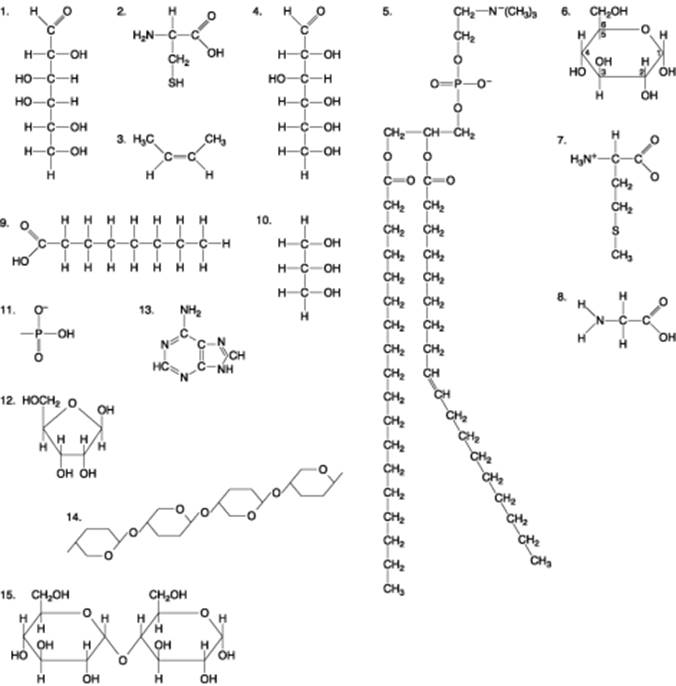
Figure 5.8
64) Which of the following molecules are structural isomers?
A) 1 and 4
B) 5 and 14
C) 6 and 12
D) 12 and 13
E) 14 and 15
Answer: A
Topic: Concept 5.2
Skill: Comprehension
65) Which of the following combinations could be linked together to form a nucleotide?
A) 1, 2, and 11
B) 3, 7, and 8
C) 5, 9, and 10
D) 11, 12, and 13
E) 12, 14, and 15
Answer: D
Topic: Concept 5.5
Skill: Comprehension
66) Which of the following molecules contain(s) an aldehyde type of carbonyl functional group?
A) 1
B) 4
C) 8
D) 10
E) 1 and 4
Answer: E
Topic: Concept 5.2
Skill: Comprehension
67) Which of the following molecules is (are) a carbohydrate?
A) 1 and 4
B) 6
C) 12
D) 5 and 14
E) all of the above
Answer: E
Topic: Concept 5.2
Skill: Comprehension
68) Which of the following molecules is a saturated fatty acid?
A) 1
B) 5
C) 6
D) 8
E) 9
Answer: E
Topic: Concept 5.3
Skill: Knowledge
69) Which of the following molecules is a purine type of nitrogenous base?
A) 2
B) 3
C) 5
D) 12
E) 13
Answer: E
Topic: Concept 5.5
Skill: Knowledge
70) Which of the following molecules act as building blocks (monomers) of polypeptides?
A) 1, 4, and 6
B) 2, 7, and 8
C) 7, 8, and 13
D) 11, 12, and 13
E) 12, 13, and 15
Answer: B
Topic: Concept 5.4
Skill: Knowledge
71) Which of the following molecules is an amino acid with a hydrophobic R group or side chain?
A) 3
B) 5
C) 7
D) 8
E) 12
Answer: C
Topic: Concept 5.4
Skill: Comprehension
72) Which of the following molecules could be joined together by a peptide bond as a result of a dehydration reaction?
A) 2 and 3
B) 3 and 7
C) 7 and 8
D) 8 and 9
E) 12 and 13
Answer: C
Topic: Concept 5.4
Skill: Comprehension
73) A fat (or triacylglycerol) would be formed as a result of a dehydration reaction between
A) one molecule of 9 and three molecules of 10.
B) three molecules of 9 and one molecule of 10.
C) one molecule of 5 and three molecules of 9.
D) three molecules of 5 and one molecule of 9.
E) one molecule of 5 and three molecules of 10.
Answer: B
Topic: Concept 5.3
Skill: Comprehension
74) Which of the following molecules could be joined together by a phosphodiester type of covalent bond?
A) 3 and 4
B) 3 and 8
C) 6 and 15
D) 11 and 12
E) 11 and 13
Answer: D
Topic: Concept 5.3
Skill: Comprehension
75) Which of the following molecules is the pentose sugar found in RNA?
A) 1
B) 4
C) 6
D) 12
E) 13
Answer: D
Topic: Concept 5.5
Skill: Knowledge
76) Which of the following molecules contains a glycosidic linkage type of covalent bond?
A) 4
B) 6
C) 12
D) 13
E) 15
Answer: E
Topic: Concept 5.2
Skill: Comprehension
77) Which of the following molecules has (have) a functional group that frequently is involved in maintaining the tertiary structure of a protein?
A) 2
B) 3
C) 9
D) 11
E) 9 and 11
Answer: A
Topic: Concept 5.4
Skill: Comprehension
78) Which of the following molecules consists of a hydrophilic "head" region and a hydrophobic "tail" region?
A) 2
B) 5
C) 7
D) 9
E) 11
Answer: B
Topic: Concept 5.3
Skill: Knowledge
79) Which of the following statements is false?
A) 1 and 4 could be joined together by a glycosidic linkage to form a disaccharide.
B) 9 and 10 could be joined together by ester bonds to form a triacylglycerol.
C) 2 and 7 could be joined together to form a short peptide.
D) 2, 7, and 8 could be joined together to form a short peptide.
E) 14 and 15 could be joined together to form a polypeptide.
Answer: E
Topic: Concepts 5.2-5.4
Skill: Comprehension
Media Activity Questions
80) Carbohydrates generally have a molecular formula
A) that includes a –SH group.
B) in which carbon, hydrogen, and oxygen are present in a ratio of 1:2:1.
C) that includes a –NH2 group.
D) that includes at least one hydrocarbon tail.
E) in which carbon, hydrogen, and oxygen are present in a 2:1:2 ratio.
Answer: B
Topic: Web/CD Activity: Carbohydrates
81) A function of cholesterol that does not harm health is its role
A) in calcium and phosphate metabolism.
B) as a component of animal cell membranes.
C) as the primary female sex hormone.
D) as the primary male sex hormone.
E) None of the above; all of cholesterol's effects on the body are harmful.
Answer: B
Topic: Web/CD Activity: Lipids
82) Which of these does not contain a structural protein?
A) muscles
B) tendons
C) ovalbumin
D) spider silk
E) ligaments
Answer: C
Topic: Web/CD Activity: Protein Functions
83) The primary structure of a protein is
A) an α helix or a pleated sheet.
B) the amino acid sequence of the polypeptide chain.
C) composed of two or more polypeptide chains.
D) maintained by hydrogen bonds.
E) irregular folding.
Answer: B
Topic: Web/CD Activity: Protein Structure
84) Which of these is a difference between DNA and RNA?
A) RNA is double-stranded; DNA is single-stranded.
B) DNA is found in the nucleus; RNA is never found in the nucleus.
C) In DNA, adenine pairs with guanine; in RNA, adenine pairs with thymine.
D) DNA contains thymine; RNA contains uracil.
E) DNA consists of five different nucleotides; RNA consists of four different nucleotides.
Answer: D
Topic: Web/CD Activity: Nucleic Acid Structure
Self-Quiz Questions
85) Which term includes all others in the list?
A) monosaccharide
B) disaccharide
C) starch
D) carbohydrate
E) polysaccharide
Answer: D
86) The molecular formula for glucose is C6H12O6. What would be the molecular formula for a polymer made by linking ten glucose molecules together by dehydration reactions?
A) C60H120O60
B) C60H12O6
C) C60H102O51
D) C60H100O50
E) C60H111O51
Answer: C
87) The enzyme amylase can break glycosidic linkages between glucose monomers only if the monomers are the α form. Which of the following could amylase break down?
A) glycogen, starch, and amylopectin
B) glycogen and cellulose
C) cellulose and chitin
D) starch and chitin
E) starch, amylopectin, and cellulose
Answer: A
88) Choose the pair of terms that correctly completes this sentence:
Nucleotides are to ________ as ________ are to proteins.
A) nucleic acids; amino acids
B) amino acids; polypeptides
C) glycosidic linkages; polypeptide linkages
D) genes; enzymes
E) polymers; polypeptides
Answer: A
89) Which of the following statements concerning unsaturated fats is true?
A) They are more common in animals than in plants.
B) They have double bonds in the carbon chains of their fatty acids.
C) They generally solidify at room temperature.
D) They contain more hydrogen than saturated fats having the same number of carbon atoms.
E) They have fewer fatty acid molecules per fat molecule.
Answer: B
90) The structural level of a protein least affected by a disruption in hydrogen bonding is the
A) primary level.
B) secondary level.
C) tertiary level.
D) quaternary level.
E) All structural levels are equally affected.
Answer: A
91) Which of the following pairs of base sequences could form a short stretch of a normal double helix of DNA?
A) 5'-purine-pyrimidine-purine-pyrimidine-3' with 3'-purine-pyrimidine-purine-pyrimidine-5'
B) 5'-A-G-C-T-3' with 5'-T-C-G-A-3'
C) 5'-G-C-G-C-3' with 5'-T-A-T-A-3'
D) 5'-A-T-G-C-3' with 5'-G-C-A-T-3'
E) A, B, and D are all correct.
Answer: D
92) Enzymes that break down DNA catalyze the hydrolysis of the covalent bonds that join nucleotides together. What would happen to DNA molecules treated with these enzymes?
A) The two strands of the double helix would separate.
B) The phosphodiester bonds between deoxyribose sugars would be broken.
C) The purines would be separated from the deoxyribose sugars.
D) The pyrimidines would be separated from the deoxyribose sugars.
E) All bases would be separated from the deoxyribose sugars.
Answer: B
93) Which of the following is not a protein?
A) hemoglobin
B) cholesterol
C) an antibody
D) an enzyme
E) insulin
Answer: B
94) Which of the following statements about the 5' end of a polynucleotide strand is correct?
A) The 5' end has a hydroxyl group.
B) The 5' end has a phosphate group.
C) The 5' end is identical to the 3' end.
D) The 5' end is antiparallel to the 3' end.
E) The 5' end is the fifth position on one of the nitrogenous bases.
Answer: B
Source : http://www.johnbowne.org/ourpages/auto/2011/10/30/50036856/05_TestBank_TB.rtf
Web site link: http://www.johnbowne.org
Google key word : Biology quiz questions and answers file type : doc
Author : not indicated on the source document of the above text
If you are the author of the text above and you not agree to share your knowledge for teaching, research, scholarship (for fair use as indicated in the United States copyrigh low) please send us an e-mail and we will remove your text quickly.
Biology quiz questions and answers
If you want to quickly find the pages about a particular topic as Biology quiz questions and answers use the following search engine:
Biology quiz questions and answers
Please visit our home page
Larapedia.com Terms of service and privacy page